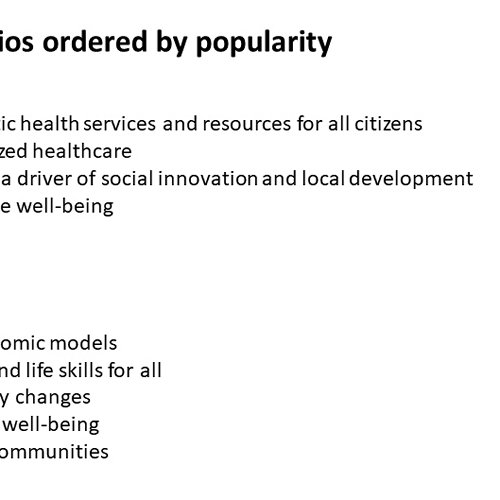Once upon a time, scientists conducted their experiments, formulated their theories and made their products inside their laboratories. They shared their results, models and theories with other experts before making the known to the rest of society. They played an undisputed leading role in technological and scientific development. Citizens were not part of the research and innovation process, they did not have a say and could not contribute to the results of science (Latour, 2004).
Voice search

Scientific citizenship and involvement of citizens
Now, however, things have changed, and citizens play a more active role in the innovative process. This is true, for various reasons, in a number of ways and in various contexts. First of all, citizens pay taxes and wish to have a say on publicly funded innovation. Yet citizens are also the end users of the scientific and technological development and their point of view is fundamental not only for those who conduct public research, but also for private citizens, because intercepting the needs also means intercepting market needs. Lastly, another essential consideration is that the new so-called “enabling” technologies – such as the Internet, 3D printing, smartphones – allow citizens themselves to become active innovators, for example by taking part in co-design projects, as happens in fab labs and makerspaces, creating real responses to their needs. In these spaces, where a “new craftwork” is created, for example, some patient communities, by expressing their needs, can take an active part in the design and development of prostheses and devices suited to their needs. It is what experts call bottom-up innovation, an approach that makes it possible to intercept the collective intelligence distributed through society and put it at the service of the community.
In the words of Pietro Greco and Vittorio Silvestrini, the era in which we now find ourselves – often defined as the “knowledge era” – is characterised “both by the irruption of science in society, and by the irruption of society in science.” The ivory tower in which scientists once worked has collapsed and the relationship between science, innovation and society is changing dramatically. This requires new – and greater! – efforts in the area of public communication of science and scientific education, even more so since research and innovation are increasingly more pervasive in our lives. We need new approaches and practices which, like society, allow us to govern innovation (rather than being governed by it).
According to the experts who deal with science and society, today there is a huge demand for more open and inclusive research and innovation, in which citizens and all players in society have a role and a space to make their contribution. Active involvement of citizens in the scientific and technological sector is very encouraging at European level, where this form of participation is often known as public engagement. In the next paragraph, we will briefly talk about a specific aspect of citizens’ involvement: public consultation to design funding plans for research and innovation.

The voice of citizens in defining research programmes
Of the various forms of public engagement in research and innovation that have been increasingly organised, there is one that is particularly interesting, and that is consultation of citizens during design of research programmes. For several years, in fact, the European Commission has been supporting projects that involve the various social players in the definition of research priorities.
The CIMULACT (Citizen and Multi Actor Consultation on Horizon 2020) project, certainly one of the most significant experiences in this area, ended last March and involved over 5000 individual citizens and 600 experts to guide public investment in research and innovation that is, as far as possible, shared and in line with the needs and expectations of society. The results of the consultation – conducted in 30 European countries, both by attended focus groups, and on line – led to identifying twelve clusters of social needs, including equality, sustainable energy and sustainable nutrition, which will help to guide European Union research programmes with the aim of connecting social needs to the innovation introduced by research. In particular, as shown in the figure below, 23 research programmes derive from Cimulact.

The 23 Cimulact research programmes, source Cimulact
Another public consultation project that has set an example at EU level, and that in a certain sense laid the methodological foundations for CIMULACT, is VOICES (Views, Opinions and Ideas of Citizens in Europe on Science). In this case, around 1000 citizens from all European countries were involved in 99 focus groups for consultation on a specific issue: urban waste. Precisely through the voices of citizens, starting from the preferences, values, needs and expectations they expressed, VOICES revealed the urgency of developing advanced technology for domestic waste management, even arriving at very tangible proposals, like development of “intelligent bins” able to separate waste based on the bar codes of the products. Again, starting from the comments by participants, it has been shown that the lack of a return for those who separate waste is a great obstacle to obtaining appropriate waste management.
There are many branches of research and innovation for which public consultation has now become more urgent. We have already talked in an article on this website about the need to consult citizens on artificial intelligence, citing as an example some tangible experiments conducted in France and in America. Yet there could be very many examples, and the renewable energy sector also deserves consideration in this sense. People know this very well in England, where the UK Energy Research Centre (UKERC), fully aware of the fact that the transition of energy towards a sustainable future cannot take place without the involvement of the citizens, is contributing to the development of new policies for public engagement in this sector.
As very many experts in the trade now state: the energy sector – and in the same way the other areas of research and innovation – is a technological and scientific issue, as much as a social one. And the transition towards a sustainable future cannot take place without the involvement of all players in society.

Photovoltaic panels
A cura di Anna Pellizzone
Per saperne di più:
- Latour B (2004) Which protocol for new collective experiments? In Henning Schmindgen (Ed) Experimental Cultures, Kadmos Verlag, Berlin, p.17
- arpa.umbria.it
- fondazionebassetti.org
- openinnovation.regione.lombardia.it



